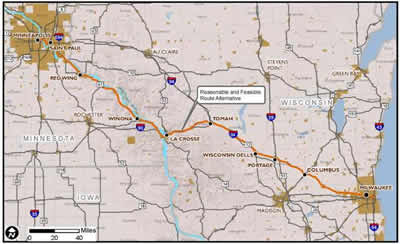Service Alternative Evaluation

The Federal Railroad Administration, in cooperation with MnDOT, is in the process of preparing a Tier 1 Service Level Environmental Impact Statement for improved passenger rail service from the Twin Cities to Milwaukee. The study of the Twin Cities to Milwaukee High-Speed Rail Corridor to Chicago will analyze improvements required for the implementation of regional intercity passenger rail service in the Minneapolis-St. Paul to Milwaukee corridor. The proposed improvements will help complete the Midwest Regional Rail Initiative (MWRRI) vision for developing an improved and expanded passenger rail system in the Midwest. The proposed service will eventually link to the existing Amtrak Hiawatha service between Milwaukee and Chicago. This study will be a major step in advancing passenger rail service in this highly populated corridor and extending service from Chicago to the Twin Cities.
Purpose
- Refine the purpose and need developed by MWRRI for the Twin Cities to Milwaukee Corridor
- Evaluate train types, levels of service, and ridership
- Identify a service alternative or alternatives that effectively and efficiently address transportation needs in the corridor.
The results of the service alternatives evaluation will be documented in a report that will summarize the analysis used to identify one or more service scenarios for improved passenger rail service. The evaluation will be based on:
- Ridership and Revenue Forecasts
- Capital Cost Estimates
- Operating Cost Estimates
- Other potential benefits and impacts
At the same time, the FRA and MnDOT are developing a refined purpose and need for the project to better reflect the transportation needs in the corridor and more accurately frame the service alternative discussion for future environmental documentation.
Project schedule
View/print complete schedule (PDF)
- 2017 – Complete Service Alternatives Analysis and Refine Purpose and Need
Next steps
The results of the service alternative analysis and the purpose and need will set the stage for Tier 1 Service Level environmental documentation. The timing of the Tier 1 Service Level environmental documentation is dependent on the availability of funding.

